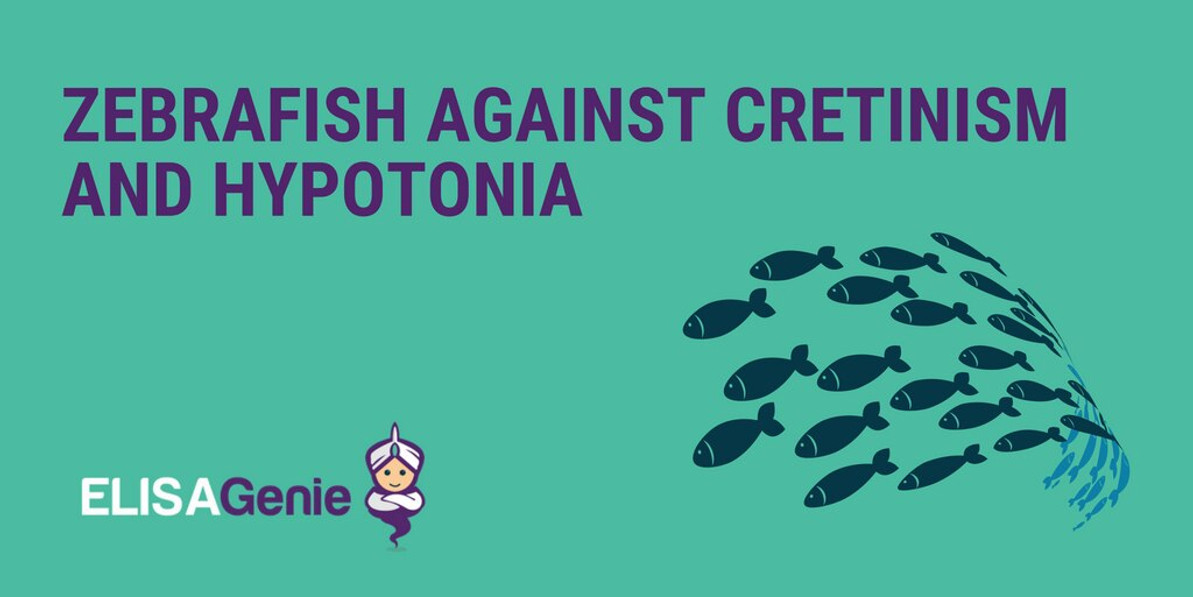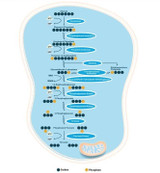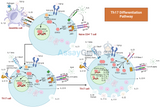Zebrafish against cretinism and hypotonia
By Natalia Siomava, PhD
Cretinism is a severe medical condition of intellectual disability caused by the deficiency of thyroid hormone (congenital hypothyroidism). Severe thyroid deficiency or maternal hypothyroidism has been reported in numerous countries all over the world. It is common in areas with iodine-deficient soils (Kapil, 2007). However, each year a greater number of infants was born with congenital hypothyroidism in countries such as North America, Europe, Australia and Japan (Harris and Pass, 2007; Hinton et al., 2010).
In these children, growth regulation and metabolism are misbalanced and the development is delayed early on. This results into various neurological problems, brain damage, and decrease of muscle tone (hypotonia). The developmental defects caused by the dysfunction of the thyroid gland are complex and ambiguous. In order to better understand hypo- and hyperthyroidism in humans, we use zebrafish (Danio rerio) as model organisms to study the variability of effects of thyroid hormone triiodothyronine (T3).
One of the great apparent pathologies caused by the T3 hormone treatment is the malformation of the fish skeleton and appendicular musculature, which is somewhat similar to hypotonia seen in children. To find out what went wrong in the T3 treated fishes with hyperthyroidism, we first need to compare it with the normal development to find discrepancies. To our surprise, we discovered that many aspects of zebrafish development are not well elaborated yet. In particular, little information is available about the myogenesis of the appendicular musculature in zebrafish (Diogo et al., 2008; Diogo and Abdala, 2010; Schneider and Sulner, 2006; Thorsen and Hale, 2005) and the basis required for the comparison is basically absent. Thus, we started our project with studying normal fin and head myogenesis in D. rerio.
Normal Development of the Appendicular Musculature
Development of the appendicular musculature starts very early, when the caudal fin is set as a posterior continuation of the body and first caudal muscles extend into the tip of the tail. Pectoral fins develop shortly after the caudal fin. Later, dorsal and ventral fin folds give rise to the dorsal and anal fins and lastly pelvic fins arise. For our experiments, we collected fishes of different developmental stages and stained them with Alizarin Red, phalloidin, and DAPI to see developing bomes and muscles. We use laser scanning microscope and obtain 150-250 optical sections that can be projected into a single image or used to reconstruct the whole fin or head in 3D.

Analyzing these scans, we found that in terms of early normal development zebrafish fins fall into two groups: i) pectoral and caudal fins; ii) dorsal, anal, and pelvic fins. Our results show that developmental patterns of the pelvic, dorsal, and anal fin musculature clearly contrast with the early development of the pectoral and caudal fin muscles. Pectoral and pelvic fin muscles become similar much later in ontogeny, mirroring what happened in fish evolution. This parallel between phylogeny and ontogeny was also reported within the head muscles of zebrafish (Diogo et al., 2008) as well in studies of muscles of various other vertebrate taxa, being thus designed as the “phylo-devo parallelism” by Diogo et al. (Diogo et al., 2015).
Notably, we found new muscles in the caudal fin that have not been previously described in zebrafish. We call these muscles interhypurales as they develop in young specimens between hypural bones and disappear later in mature fishes. This part of the project paved the way for future evo-devo comparisons and discussions about fin origin and its further transition into the tetrapod limb. Understanding the normal development also gave us a background for the comparisons with hyperthyroidism case series.
Abnormal Development of the Appendicular Musculature
Analysis of our hyperthyroidism case series revealed not only various anatomical defects in the zebrafish head and fin skeleton and muscles but also growth acceleration in general and heterochrony. Similarly to humans, we observe severe underdevelopment of the appendicular and head musculature as well as late ossification of bones that grow to strange shapes and sometimes even fuse in the caudal fin.

Interestingly, defects found in our pathological series are similar to defects caused in zebrafishes by stress of the environmental change (Miguel L Allende, pers. comm.). We think that the similarities between defects caused by completely different conditions may support Pere Alberch’s idea of ‘logic of monsters’, according to which evolution is so constrained that even when it goes ‘wrong’ – e.g. in cases of severe defects – the resulting phenotypes mirror those seen in other abnormal conditions as well as those seen in the natural variations and/or normal phenotype of other taxa.
Recently, some studies were performed to define genes that are affected by the thyroid hormone and our colleagues in Moscow (Russia) composed a list of genes that are differentially expressed in fished reared in a solution of exogenous triiodothyronine (Rastorguev et al., 2016). We know what genes are mostly affected in the head or other body parts. The next step of our study would thus be to go from the organismal (anatomical) level to a molecular level. We plan to perform whole mount in situ hybridisation and gene functional studies to find what gene pathways were affected and led to the defective phenotypes.
Natalia Siomava, PhD
Department of Anatomy, Howard University College of Medicine
References
- 520 W Street NW, 20059 Washington, DC, USA
- Diogo, R., Abdala, V., 2010. Muscles of vertebrates: comparative anatomy, evolution, homologies and development. Science Publishers, Enfield, N.H.
- Diogo, R., Hinits, Y., Hughes, S.M., 2008. Development of mandibular, hyoid and hypobranchial muscles in the zebrafish: homologies and evolution of these muscles within bony fishes and tetrapods. BMC Dev. Biol. 8, 24. doi:10.1186/1471-213X-8-24
- Diogo, R., Smith, C.M., Ziermann, J.M., 2015. Evolutionary developmental pathology and anthropology: A new field linking development, comparative anatomy, human evolution, morphological variations and defects, and medicine: Evolutionary Developmental Pathology and Anthropology. Dev. Dyn. 244, 1357–1374. doi:10.1002/dvdy.24336
- Harris, K.B., Pass, K.A., 2007. Increase in congenital hypothyroidism in New York State and in the United States. Mol. Genet. Metab. 91, 268–277. doi:10.1016/j.ymgme.2007.03.012
- Hinton, C.F., Harris, K.B., Borgfeld, L., Drummond-Borg, M., Eaton, R., Lorey, F., Therrell, B.L., Wallace, J., Pass, K.A., 2010. Trends in Incidence Rates of Congenital Hypothyroidism Related to Select Demographic Factors: Data From the United States, California, Massachusetts, New York, and Texas. Pediatrics 125, S37–S47. doi:10.1542/peds.2009-1975D
- Kapil, U., 2007. Health consequences of iodine deficiency. Sultan Qaboos Univ. Med. J. 7, 267.
- Rastorguev, S.M., Nedoluzhko, A.V., Levina, M.A., Prokhorchuk, E.B., Skryabin, K.G., Levin, B.A., 2016. Pleiotropic effect of thyroid hormones on gene expression in fish as exemplified from the blue bream Ballerus ballerus (Cyprinidae): Results of transcriptomic analysis. Dokl. Biochem. Biophys. 467, 124–127. doi:10.1134/S1607672916020137
- Schneider, H., Sulner, B., 2006. Innervation of dorsal and caudal fin muscles in adult zebrafishDanio rerio. J. Comp. Neurol. 497, 702–716. doi:10.1002/cne.21038
- Thorsen, D.H., Hale, M.E., 2005. Development of zebrafish (Danio rerio) pectoral fin musculature. J. Morphol. 266, 241–255. doi:10.1002/jmor.10374
Recent Posts
-
Biological Role of GLP-1
Glucagon-like peptide-1 (GLP-1) is a critical hormone in the regulation of glucose met …20th Jun 2024 -
Th17 Cell Differentiation: Insights into Immunological Dynamics
Th17 cells, a subset of T helper cells characterized by their production of interleukin-17 (IL- …25th May 2024 -
Assay Genie New Asian Distributor May 2024
Dublin, Ireland — May 20th 2024 — Assay Genie, a leading supplier of ELISA Kits, Ant …19th May 2024




